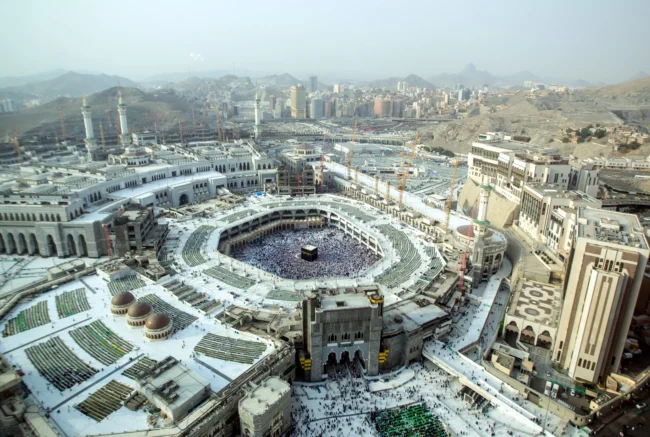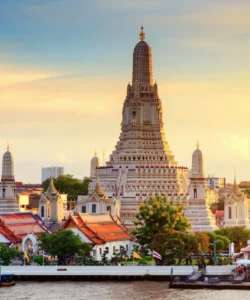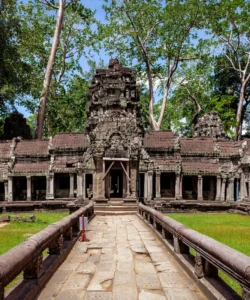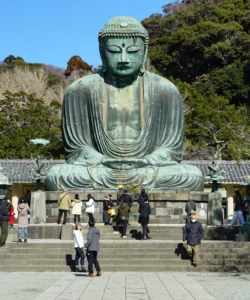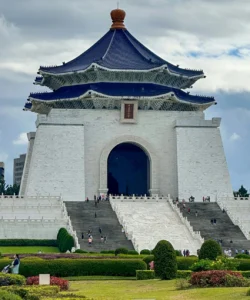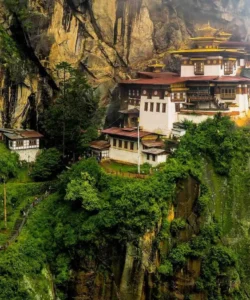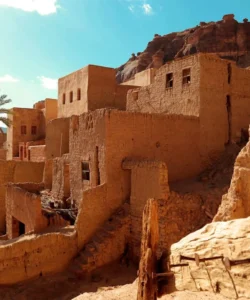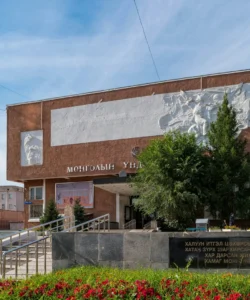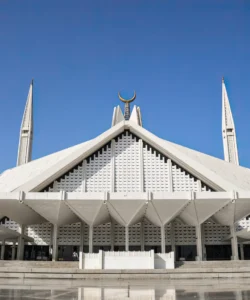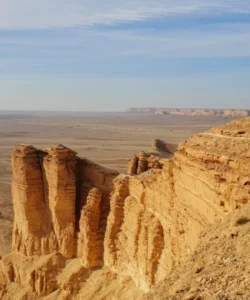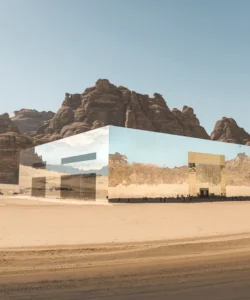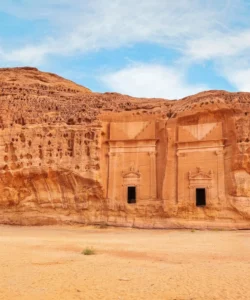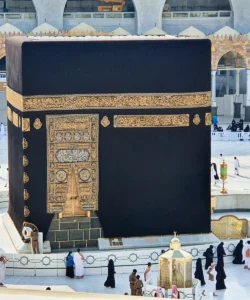Al-Masjid Al-Haram (Arabic: ٱَلْمَسْجِدُ ٱلْحَرَام, romanized: al-Masjid al-Ḥarām, lit. ‘The Sacred Mosque’), also known as the Great Mosque of Mecca, is the largest mosque in the world and surrounds Islam’s holiest site, the Kaaba, in the city of Mecca, Saudi Arabia. It is the ultimate spiritual center of Islam, serving as the focal point for all Muslims worldwide during their daily prayers (Qiblah) and the main site for the Hajj and Umrah pilgrimages.
Name: Al-Masjid Al-Haram (The Sacred Mosque, The Grand Mosque, The Great Mosque of Mecca)
Address: Mecca City, Mecca Province, Saudi Arabia. The mosque is situated in the heart of Mecca, a city located in the western region of Saudi Arabia, nestled amidst mountains like Abu Qubays and Ajyad.
How to Get There:
Access to Al-Masjid Al-Haram is highly restricted to Muslims only, especially to Mecca itself.
- By Air: The closest international airport is King Abdulaziz International Airport (JED) in Jeddah. From Jeddah, a well-established transportation network (buses, taxis, private cars) takes pilgrims to Mecca (approx. 1-1.5 hours drive). A new high-speed rail line, the Haramain High-Speed Railway, also connects Jeddah, Mecca, and Medina.
- By Road: Mecca is well-connected by modern highways from all parts of Saudi Arabia.
- Pilgrimage Regulations: Access to Mecca and Al-Masjid Al-Haram is permitted only for Muslims. Non-Muslims are strictly prohibited from entering the holy city. During Hajj and Umrah seasons, millions of pilgrims arrive, and sophisticated crowd management systems are in place.
- Within the Mosque: The mosque is designed for massive pedestrian flow. It has over 210 gates, with many equipped with escalators and lifts for accessibility. The vast prayer halls and courtyards are easily navigable on foot. Wheelchairs are available for those with disabilities.
- Best Time to Visit: The mosque is open 24 hours a day, 7 days a week. The peak times are during the annual Hajj pilgrimage (month of Dhu al-Hijja in the Islamic calendar) and the Umrah pilgrimage (can be performed anytime). These periods see the largest gatherings. Outside of peak pilgrimage times, it’s generally less crowded.
Landscape and Architecture:
Al-Masjid Al-Haram is a monumental complex that has undergone centuries of expansion and renovation, blending traditional Islamic architectural elements with modern engineering to accommodate millions of worshippers.
- The Kaaba: At the absolute center of the mosque’s courtyard (the Mataf) stands the Kaaba, a cubic structure (approximately 12 meters high and 10-12 meters long). It is the most sacred structure in Islam, faced by Muslims worldwide during daily prayers. It is constructed from granite stones and draped annually with the Kiswa, a black silk cloth embroidered with gold calligraphy.
- Mataf (Circumambulation Area): The vast, open circular area surrounding the Kaaba is known as the Mataf, where pilgrims perform the ritual circumambulation (Tawaf). This area is paved with natural stone and kept minimalist to emphasize the Kaaba’s sanctity.
- Minarets: The mosque has 13 towering minarets, some reaching up to 139 meters (456 feet) in height. These minarets are a prominent feature of the mosque’s exterior, complementing its grandeur and marking its vast expanse.
- Domes and Arches: While the central Kaaba is dome-less, the mosque complex features numerous elegant domes and vast prayer halls with rows of pillars and arches that create a sense of symmetry and harmony. Earlier renovations in the 8th century replaced wooden columns with marble and later additions by the Ottomans (16th century) introduced domes decorated with calligraphy. Modern expansions have incorporated new domes and extensive prayer spaces.
- The Black Stone (Al-Hajar al-Aswad): Embedded in the eastern corner of the Kaaba, this revered stone is believed to have descended from Paradise. Pilgrims seek to kiss or touch it during Tawaf.
- Maqam Ibrahim: Opposite the Kaaba’s door, this golden structure houses a stone believed to bear the footprint of Prophet Abraham, who stood on it as he built the Kaaba.
- Zamzam Well: Located beneath the mosque’s floor, the Zamzam well is a miraculous spring that appeared under Prophet Ismail’s feet. Its purified water is provided through thousands of taps throughout the mosque complex.
- Safa and Marwa Hills (Masa’a Gallery): The two small hills of Safa and Marwa, between which Hagar (Ismail’s mother) ran seeking water, are now enclosed within the mosque complex by a long, multi-storey gallery (the Masa’a), where pilgrims perform the ritual of Sa’i (walking back and forth).
- Vast Capacity: The mosque is designed to accommodate a colossal number of worshippers. It has a total area of approximately 356,000 to 380,000 square meters (88-94 acres) and can hold up to 2.5 to 4 million worshippers, especially during peak Hajj times, making it the largest mosque in the world by capacity.
- Luxurious Materials and Modern Amenities: The mosque is constructed using high-quality marble and natural stone. Modern innovations include air conditioning (circulating from below the tiled floors), escalators, and advanced crowd management systems to ensure comfort and safety for millions of pilgrims.
What Makes It Famous:
- Holist Site in Islam: Al-Masjid Al-Haram is the most sacred site in Islam, the Qiblah (direction of prayer) for Muslims worldwide, and the central destination for the mandatory Hajj pilgrimage and the Umrah. Its spiritual significance is unparalleled.
- Largest Mosque in the World: It holds the title of the largest mosque globally by capacity and area, a testament to its monumental scale and importance. It is also considered the most expensive building in the world.
- The Kaaba: As the ancient cubic structure believed to be built by Prophets Abraham and Ismail, the Kaaba is the focal point of devotion and prayer for billions of Muslims, making it the most iconic structure within the mosque.
- Historical and Prophetic Significance: Its origins trace back to Prophet Abraham, and it was purified and transformed by Prophet Muhammad, making it central to Islamic history.
- Unifying Symbol: The mosque serves as a powerful symbol of unity and solidarity for the entire Muslim Ummah (community) globally, bringing millions together in shared worship.
- Modern Engineering and Expansion: The mosque has undergone continuous, massive expansions, particularly in the Saudi era, employing cutting-edge modern architectural and engineering technologies to accommodate the ever-increasing number of pilgrims while preserving its sacred essence.
- Zamzam Well: The miraculous Zamzam water, flowing continuously for millennia, is a significant part of the mosque’s sacred history and a source of blessing for pilgrims.
Differences from Some Other Wonders:
- Ultimate Religious Centrality: While other sites are sacred (e.g., Vatican City for Catholicism, Jerusalem for multiple faiths), Al-Masjid Al-Haram holds a unique and universal centrality for over two billion Muslims worldwide as the Qiblah and the primary site for the Hajj pilgrimage, a level of direct religious focus unmatched by any other single structure.
- Focus on Ritual Performance: The mosque’s design and layout are entirely optimized for the performance of specific Islamic rituals, primarily Tawaf (circumambulation of the Kaaba) and Sa’i (walking between Safa and Marwa). Its “architecture” facilitates these specific acts of worship.
- Kaaba as a Symbolic Center: Unlike other mosques with large prayer halls as their central space (e.g., Badshahi Mosque, Sultan Omar Ali Saifuddien Mosque), Al-Masjid Al-Haram’s spiritual and architectural core is the Kaaba itself, a simple, dome-less cube, around which all activity revolves.
- Exclusive Access (Muslims Only): The strict prohibition of non-Muslims from entering Mecca and Al-Masjid Al-Haram makes it a highly exclusive and sacred destination, contrasting with most other wonders that are open to all visitors.
- Continuous Mass Expansion: While many historical sites undergo restoration, Al-Masjid Al-Haram is characterized by its continuous, massive, and technologically advanced expansions designed to cope with millions of simultaneous visitors, a scale of ongoing development almost unparalleled globally for a single religious building.
- Ancient Origins with Modern Tech: It uniquely combines an ancient, foundational structure (the Kaaba) with cutting-edge modern infrastructure (air conditioning, escalators, digital guidance systems) to serve a colossal number of contemporary pilgrims.
- Living, Functioning Shrine (vs. Historical Site): While it has deep history, its primary identity is as a living, vibrant, and active place of continuous worship and pilgrimage, rather than a historical or archaeological site primarily for viewing (like the ruins of Angkor Wat or Mohenjo-daro).
Al-Masjid Al-Haram Photos:
[envira-gallery id=”17319″]
